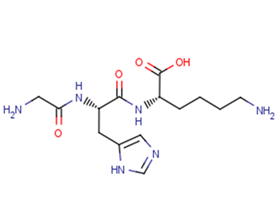
Glycyl-L-Histidyl-L-Lysine
CAS No. 49557-75-7
Glycyl-L-Histidyl-L-Lysine( —— )
Catalog No. M18652 CAS No. 49557-75-7
Glycyl-L-histidyl-L-lysine is a liver cell growth factor and an asynthetic hepatotrophic agent that stimulates hepatic erythropoietic factor production.
Purity : >98% (HPLC)
 COA
COA
 Datasheet
Datasheet
 HNMR
HNMR
 HPLC
HPLC
 MSDS
MSDS
 Handing Instructions
Handing Instructions
| Size | Price / USD | Stock | Quantity |
| 100MG | 26 | In Stock |


|
| 1G | 27 | In Stock |


|
Biological Information
-
Product NameGlycyl-L-Histidyl-L-Lysine
-
NoteResearch use only, not for human use.
-
Brief DescriptionGlycyl-L-histidyl-L-lysine is a liver cell growth factor and an asynthetic hepatotrophic agent that stimulates hepatic erythropoietic factor production.
-
DescriptionGlycyl-L-histidyl-L-lysine is a liver cell growth factor and an asynthetic hepatotrophic agent that stimulates hepatic erythropoietic factor production.
-
In VitroGlycyl-L-histidyl-L-lysine and its copper complexes and saccharomyces/copper ferment on secretion of pro-inflammatory IL-6 in normal human dermal fibroblasts NHDF cell line.Glycyl-L-histidyl-L-lysine and its copper complexes decreases TNF-α-dependent IL-6 secretion in fibroblasts.
-
In VivoGlycyl-L-histidyl-L-lysine (intraperitoneal injection; 1.5, 5, 50, 150, and 450 mg/kg; 10 times ) can stimulate mitotic activity of hepatocytes and dose-dependently suppresse immune reactivity.Glycyl-L-histidyl-L-lysine (intraperitoneal injection; 0.5, 5, and 50 μg/kg) can produce an anxiolytic effect in the elevated plus maze test.
-
Synonyms——
-
PathwayOthers
-
TargetOther Targets
-
RecptorOthers
-
Research AreaInflammation/Immunology
-
Indication——
Chemical Information
-
CAS Number49557-75-7
-
Formula Weight340.38
-
Molecular FormulaC14H24N6O4
-
Purity>98% (HPLC)
-
SolubilityIn Vitro:?H2O : 100 mg/mL (293.79 mM)
-
SMILESNCCCC[C@H](NC(=O)[C@H](CC1=CN=CN1)NC(=O)CN)C(O)=O
-
Chemical Name——
Shipping & Storage Information
-
Storage(-20℃)
-
ShippingWith Ice Pack
-
Stability≥ 2 years
Reference
1.Naughton BA,etal.The influence of pancreatic hormones and diabetogenic procedures on erythropoietin production.J Surg Oncol. 1982 Oct;21(2):97-103.
molnova catalog



related products
-
(R)-3-Hydroxybutanoi...
3-hydroxybutyric acid is involved in the synthesis and degradation of ketone bodies. Like the other ketone bodies (acetoacetate and acetone) levels of beta-hydroxybutyrate are raised in the blood and urine in ketosis. Beta-hydroxybutyrate is a typical partial-degradation product of branched-chain amino acids (primarily valine) released from muscle for hepatic and renal gluconeogenesis.
-
SLV319
SLV319 has been used in trials studying the treatment of Obesity and Obesity and Type 2 Diabetes.
-
CYM5181
CYM5181 is related to the body's immune system and can be used to study multiple sclerosis, transplant rejection, and adult respiratory distress syndrome.



 Cart
Cart
 sales@molnova.com
sales@molnova.com


